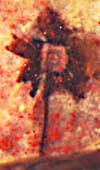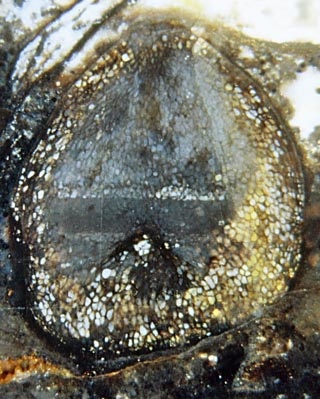Talking about diffusion and
silicification
It is surprising that a simple everyday phenomenon like diffusion is
occasionally not really understood even by scientists. So it is worth
while talking about it with the aim to provide essential understanding
without resorting to mathematics.
For an explanation of what diffusion means, teachers usually resort to
the
popular example of a cup of tea with a lump of sugar placed on the
bottom, where the sweet taste spreads with time even if there is not
the slightest motion of the tea. Hence it can be said that the effect
of diffusion is substance transport without motion in the sense of
liquid or gas flow, or, for short:
"Diffusion = Substance transport without flow"
Diffusion is a main way of substance transport
in mineral deposition, including flint
and chert
formation, and thus is
essential for fossilisation. Geologists unfamiliar with the concept of
diffusion did have a difficult job when trying to explain every mineral
deposition with their favourite notion of "circulating solutions".
Filling a cavity with a solid deposit would require an odd regime with
repeated inflow
and outflow of solutions. Since "circulating solutions" is a more
vivid concept than diffusion, it has survived in minds and publications
up to now.
Redistribution of substances resulting in crystal growth is often
ascribed to substance transport by liquids or fluids moving along
fissures
in hot rocks in the depth
while diffusion as the main transport process is not even mentioned
(as,
for example, in the National Museum of Scotland, Edinburgh).
 Fig.1:
Mineral aggregate in fossiliferous chert, Lower
Permian, Döhlen basin, Saxony.
Fig.1:
Mineral aggregate in fossiliferous chert, Lower
Permian, Döhlen basin, Saxony.
What looks like a bizarre flower in the picture on the right is a
mineral
aggregate whose history can be reconstructed: Silica-rich swamp water
turned into silica gel, decaying organic matter produced H2S
which combined with dissolved iron compounds into insoluble FeS, which
appeared as tiny cubic pyrite crystals suspended in the gel. The
crystals
grew as more sulfur and iron ions approached them by diffusion.
Eventually the reducing environment turned oxidising, whereupon the
pyrite slowly decayed into sulfate and iron oxides. The sulfate ions
combined
with dissolved Ca into gypsum, whose crystals, stained
dark probably by iron oxides, grew immediately on the faces of the
pyrite
cube in this picture, which became replaced by chalcedony in the
process. All this occurred without any flow of a solution. The
"flower stalk", which is an old crack, could possibly have
contributed to the transformations since cracks are easy diffusion
paths.
While fluid flows have a well defined velocity at any position
and time, velocity is not a reasonable concept for diffusional flows.
This is apparent from the fact that the time required for a substance
to spread over a distance by diffusion is proportional to the square of
distance. With a microbe 104
times smaller than a tea cup, any substance would spread throughout the
microbe 108 times
faster than throughout the tea. So it can be stated that substance
transport by diffusion is slow over larger distances but very fast and
efficient over very small distances. This is the reason why liquid flow
systems had to be invented by living beings when they evolved from
unicellular to big ones.
It is the motion on the molecular
scale which brings about substance transport by diffusion. This can be
visualized by means of
the following thought experiment, which could be performed in reality
as well.
Imagine a table with lots of little balls on it and with a
rim along the edges so that they cannot roll off. Let there be red and
blue balls, neatly
sorted so that they occupy
the left and right side of the table, respectively, separated by an
imaginary line in the middle. By shaking the table violently, the balls
get into random motion,
bouncing from the rim and from each other, which is analogous to
the thermal motion of molecules. This motion will gradually take more
and more balls into the other half of the table until finally the red
and blue ones are equally distributed.
One can easily imagine that the mixing is quickest at the beginning
when the concentration profiles of the red and blue balls are
step-like, and gets slower as the profiles become smoothed. This is
expressed more precisely by the statement that the diffusional flow is
proportional to the concentration gradient.
As an extension of this experiment, let there be light and heavy balls.
The heavy balls would be slower on average. From statistical mechanics
it is known that the average kinetic energy is the same for all,
irrespective of weight. This means that water molecules move more
than 4 times faster than the 19 times heavier sugar molecules, since
the
square root of 19 is about 4.3.
Up to here, this may have seemed so simple to some readers that it has
been boring. However, as some scientists may stumble already at this
modest
step of knowledge, it is formulated here once more in other words: The
sugar molecules with their slow random motion move from the sweet tea
below to the less sweet tee above, and the water molecules with their
fast random motion squeeze themselves in between and occupy quickly the
places where the sugar molecules have left.
This has not been realized by M. Landmesser
as he claims, in connection
with silicification, that the solvent does not diffuse [1]. Quite the
opposite is true at some stage of silicification where the silica
clusters become so big that they hardly move but the water molecules
slip between them as quickly as ever. Even at the more advanced stage
of silica gel, water is able to diffuse through the meshes. By
neglecting the diffusion of water one would not be able to understand
some details of the fossilisation process. Nevertheless, the work of
Landmesser
on silicification has been defended by R. Rössler
as particularly thorough [2].

Less obvious is the mechanism behind a peculiar feature of diffusion:
The diffusional flow of substance through a hole in a sheet is not
proportional to the area of the hole but to its diameter. This means
that perforated sheets with equal total hole area but unequal hole
sizes let more substance pass if the holes are small, which is quite
essential in substance transport through biological membranes.
For an explanation, one additional idea is required, a rough
estimate of the concentration gradient of the diffusing substance at
the hole. Since the diffusional flow diverges as it comes out of the
hole, the
concentration decays rapidly with distance there. As a reasonable
assumption, the
concentration is essentially diminished at distances about
equal to the hole diameter d.
This provides an estimate for the concentration gradient:
concentration at the hole divided by d. Hence,
small holes make steep gradients and thus high diffusional flow density. The
flow or transport through the
hole is flow density multiplied by hole area, and since the
flow density is proportional to 1/d
and the
area is proportional to d2,
the
flow is proportional to d
but not to d2
as in the case of fluid flow.
Apparently this explanation of the phenomenon is not
generally known
among biologists. An encyclopedia of biology proposes an explanation
based on the assumption that diffusion is concentrated at the
circumference of the hole and therefore
is proportional to the diameter.
Furthermore, not even the experimentally established phenomenon itself
is generally known among scientists who work on diffusion in plants.
Theoretical results on diffusion through perforated walls offered as
elaborate formulae can be easily checked: If they contain the total
area of the holes but not the hole size, they cannot be right.
Fig.2: Corm of the Lower Devonian plant Horneophyton
with
level bands resulting from silica cluster suspensions pervading the
tissue by diffusion probably through holes in the degraded cell walls.
Three pictures illustrating diffusion effects in chert are explained in
Permian
Chert News 13.
H.-J. Weiss
2013, 2015
[1] M. Landmesser:
Zur Entstehung von Kieselhölzern, extraLapis No.7 (1994), 49-80.
[2] R. Rössler:
Der versteinerte Wald von Chemnitz. Museum f. Naturkunde Chemnitz 2001,
p.198.
 Fig.1:
Mineral aggregate in fossiliferous chert, Lower
Permian, Döhlen basin, Saxony.
Fig.1:
Mineral aggregate in fossiliferous chert, Lower
Permian, Döhlen basin, Saxony.